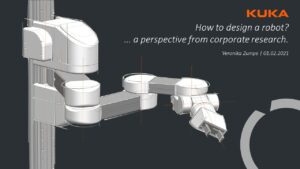Archive for January, 2021
IGMR Seminar 01. Februar 2021 14:30 Uhr: Veronika Zumpe, Kuka AG
Wir begrüßen Frau Veronika Zumpe von Kuka zum IGMR Seminar. Auch dieser Veranstaltung wird weiterhin virtuell durchgeführt:
How to design a robot. A perspective from corporate research.
For specific handling tasks, there is a need for the development of new robotic systems. It is necessary to develop and design the system with respect to the given task, environment and other constraints. The design process includes finding a suitable kinematic, developing drive concepts for the robot axes, designing the structural parts and finalizing the robot design. For applications with human robot collaboration, more aspects like lightweight design play a significant role and thus should be taken into account. This talk gives a rough overview of the design process of a robot from my corporate research perspective.
Montag, 01. Februar 2021 14:30 Uhr in Zoom
https://rwth.zoom.us/j/98454895570?pwd=NkpiSWkyaTJtdWlralJrSUtnMDdDZz09
Meeting-ID: 984 5489 5570
Kenncode: 186393
Die Datenschutzhinweise zur Nutzung von Zoom und eine Handreichung für Teilnehmer (Studierende) können von den Seiten des CLS der RWTH Aachen University heruntergeladen werden.
Die Veranstaltungen im Wintersemester 2020/2021 werden in Zusammenarbeit mit dem VDI-GPP-Arbeitskreis des Bezirksvereins Aachen durchgeführt.
Ansprechpartner:
IGMR Seminar 26.01.2021: Robert Grafe, Deutsches Rettungsrobotik-Zentrum e.V.
Unbemannte Systeme in der Gefahrenabwehr, der Aufbau des Deutsches Rettungsrobotik-Zentrums.
https://youtu.be/anZtJAajQy0
Wir begrüßen Herrn Grafe vom DRZ zum IGMR Seminar. Auch dieser Veranstaltung wird weiterhin virtuell durchgeführt:
Unbemannte Systeme in der Gefahrenabwehr, der Aufbau des Deutsches Rettungsrobotik-Zentrums Die Nutzung unbemannter, bodengebundener Systeme bietet großes Potential, Einsatzkräfte von Hilfsorganisationen und Feuerwehren bei besonders gefährlichen oder zeitraubenden Einsätzen zu unterstützen. Auf Grund der anspruchsvollen Aufgaben und Szenarien ist der Sprung von der Forschung in die reale Nutzung jedoch bisher nur vereinzelt geglückt. Der Vortrag stellt diesen Stand von Forschung und Entwicklung dar und beschreibt den Ansatz, welcher mit der Gründung des Deutschen Rettungsrobotik-Zentrums beschritten wird, um die Realisierung von praxis-/ und produktnahen Lösungen zu fördern.
Dienstag, 26. Januar 2021 16:30 Uhr in Zoom
Zoom Meeting Informationen:
https://rwth.zoom.us/j/98454895570?pwd=NkpiSWkyaTJtdWlralJrSUtnMDdDZz09
Meeting-ID: 984 5489 5570
Kenncode: 186393
Die Datenschutzhinweise zur Nutzung von Zoom und eine Handreichung für Teilnehmer (Studierende) können von den Seiten des CLS der RWTH Aachen University heruntergeladen werden.
Die Veranstaltungen im Wintersemester 2020/2021 werden in Zusammenarbeit mit dem VDI-GPP-Arbeitskreis des Bezirksvereins Aachen durchgeführt.
Weitere Informationen können auch dem Blog-Beitrag IGMR als Mitglied des Deutsches Rettungsrobotikzentrum e.V entnommen werden.
Ansprechpartner:
Manipulator-specific path planning for multidirectional additive manufacturing
In a joint research project between the IGMR and the ISF of RWTH Aachen University, research is being conducted on the Multidirectional Additive Manufacturing of metallic components.
With the aid of Multidirectional Additive Manufacturing (MDAM), it is possible to build complex components layer by layer and without the need for support structures. By moving the base plate by means of an industrial robot while the welding gun remains fixed, the component to be printed can always be oriented in such a way that support structures can be avoided. The major challenge lies in the consideration of specialized welding processes with external wire feeding and the use of sensors for process monitoring. This results in a dependency of the orientation of the welding gun compared to the currently printed path.
As part of his master’s thesis, Jan Wiartalla developed a path planning algorithm that calculates an executable and, if possible, continuous path within specified, flat part slices that completely fills the cross-sectional area. This is done robot-specific, so that the algorithm always takes the robot currently in use as well as its limitations into account. A standardized interface allows for the robot model to be easily exchanged and the algorithm can thus quickly be adapted to different test environments. The video illustrates the algorithm’s procedure in a simplified way.
https://youtu.be/chuD57ja9JE
Contacts:




